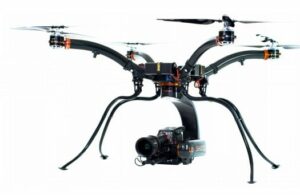
 Shotover, a manufacturer of high-performance stabilization platforms, has announced the debut of the Shotover U1, a professional-grade unmanned aerial vehicle (UAV) for the broadcast, motion picture, law enforcement and industrial survey markets. The U1 accommodates cinema-quality cameras and lenses including the 6K RED Weapon, ARRI Alexa Mini, Phantom Flex4K and Sony F55 cameras and the Canon 17-120mm, Fujinon 85-300 and Optimo 28-76 lenses. This flexibility allows operators to carry the right payload for whatever the mission requires.
Shotover, a manufacturer of high-performance stabilization platforms, has announced the debut of the Shotover U1, a professional-grade unmanned aerial vehicle (UAV) for the broadcast, motion picture, law enforcement and industrial survey markets. The U1 accommodates cinema-quality cameras and lenses including the 6K RED Weapon, ARRI Alexa Mini, Phantom Flex4K and Sony F55 cameras and the Canon 17-120mm, Fujinon 85-300 and Optimo 28-76 lenses. This flexibility allows operators to carry the right payload for whatever the mission requires.
Further increasing functionality, the Shotover U1 gimbal (U1g) can be detached from the multirotor and used as a standalone gyro-stabilized platform for mounting on motorcycles, cars, boats, cables and almost anything that moves. Buyers can choose between the U1, which includes both the multirotor and gimbal, and the U1g, which is the gimbal without the aerial component. Other U1 features include redundant flight control and battery systems, customized downlink with two HD video feeds and unparalleled stability even at full zoom.
The U1 builds upon Shotover’s expertise in the aerial cinematography space with its Shotover F1 and Shotover K1 gyro-stabilized camera systems. Recent credits include Hollywood blockbusters Jurassic World, Furious 7 and Spectre; Shotover has also been tapped by the BBC for filming telephoto 4K footage of wolves, bears and caribou in Canada’s remote Northwest Territories for a six-part wildlife documentary series scheduled to air in 2016.
“The Shotover U1 is the first drone specifically designed for broadcasters and big budget filmmakers, allowing productions to employ the same professional grade cameras and lenses they choose for their principal photography,” said Shotover president Alex Giuffrida. “Coupled with unsurpassed reliability and support, the U1 will enable cinematographers to capture breathtaking shots, including those that wouldn’t be possible with a helicopter or crane – such as from inside a waterfall – without having to sacrifice image quality. For law enforcement and industrial users such as those from the oil & gas, agriculture and real estate industries, the U1 offers a drone option that can be employed in place of aircraft-mounted solutions.”
The U1’s redundant battery system with on screen feedback of cell voltage and capacity allows the pilot to turn off a failed battery cell and get the ship home safely. The redundant flight control system provides operators with the ability to quickly switch to a back-up flight controller if the need arises. Additional features of the U1 include a user-friendly design that allows operators to easily swap cameras and lenses during a shoot, 10X more pan motor torque than prosumer gimbals and a unique balancing system for unshakeable stability. Like all Shotover systems, the U1 has no ITAR restrictions, enabling it to be shipped around the world without requiring U.S. State Department approval.


















